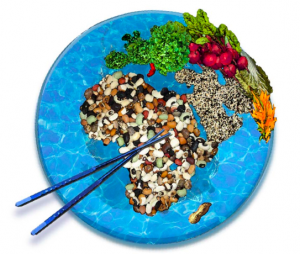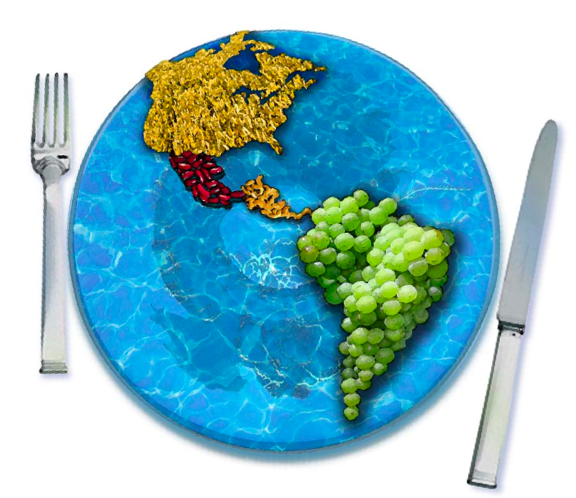By James Martin
We can’t keep eating like this. The United Nations’ Food and Agricultural Organization estimates that, by 2050, we will have to increase food production by 70 per cent in order to nourish the world’s population. Geography professor Navin Ramankutty and his team of international colleagues have a five-point plan that they think just might do the trick.

Sometime in autumn 2011, the world population hit the seven billion mark. It was a bittersweet occasion, as our growing population threatens to push our resources to their breaking point. After all, that milestone baby, along with the other 6,999,999,999 of us, needs to eat. Once you consider that the human race is set to crack nine billion by 2050, the world’s collective pantry shelves are looking mighty bare.
That’s the bad news. The good news is that we can do a much more efficient, and Earth-friendly, job producing the world’s food. Navin Ramankutty is an associate professor in McGill’s Department of Geography and a researcher in the Global Environmental and Climate Change Centre. Along with Jonathan Foley, professor at the University of Minnesota, Ramankutty is a team leader on an international research project that aims to improve food production and consumption around the world. In the October 2011 issue of Nature, the team—which brought together researchers from McGill, Minnesota, Arizona State University and the Universities of Bonn, California at Santa Barbara, Stockholm and Wisconsin—published a five-point guide for feeding ourselves, sustainably (see sidebar). “Solutions for a Cultivated Planet,” the first in a series of articles to be published in various journals over the coming months, stems from a study that pairs agricultural census data and satellite images with mathematical models of our world’s crop production systems. The approach offers an unprecedented degree of geographic exactness that would have been unheard of just 20 years ago.
“We need this kind of geographically explicit data,” says Ramankutty. “It’s not enough to just know that six per cent of Canada is cultivated without knowing exactly where. Even today, many scholars do analysis using national statistics. So they have one number for all of the U.S., one number for all of Canada, and so on. Some may get state-level or provincial-level data. But with satellites, you can get into much greater detail; you can tell exactly where agriculture is happening, kilometer by kilometer.”
By combining satellite data and census statistics, the researchers have developed spatial information on the area and yields for 175 different crops around the world. They also have climate and soil data, at the same resolution. “Now we’re able to build models that relate all this data,” says Ramankutty, “because we know where land is being used for agriculture, exactly what kinds of crops are being grown, how much fertilizer is being used, how much irrigation is being applied. When we overlay all that data, we can find out exactly how much nitrogen fertilizer is being used to grow maize in southern Quebec, for example.”

The solutions being proposed aren’t new. What is new about this study, however, is its ability to quantify how much difference each change could make. “Qualitatively, we knew these things were useful, but we didn’t know if they were key leverages or small players,” says Ramankutty. “Would closing yield gaps solve 10 per cent of the problem or 50 per cent of the problem? For the first time, we can quantify these things. Now we know that if we make a concerted effort in the right geographic areas, these five things can play a big role in feeding the planet without destroying it.”
This research was funded by the Natural Sciences and Engineering Research Council of Canada, the National Aeronautics and Space Administration and NSF International.
In their research paper “Solutions for a Cultivated Planet,” Navin Ramankutty and his colleagues propose five steps for producing more food without damaging the planet:
- Stabilize land in production. Need to grow more food? Devote more land to farming, right? Wrong. “If we look at the last 40 years,” says Ramankutty, “most of our increased food production hasn’t come from expansion — it’s come from increased intensification using irrigation and fertilizer.” (A country like India, where more than half the land is already devoted to agriculture, doesn’t have much room to grow anyway.) Expanding agricultural endeavours, especially into sensitive tropical ecosystems, can have a detrimental impact on biodiversity, carbon storage and the planet’s general well-being. And tropical deforestation in the name of agriculture isn’t just bad for the environment: It doesn’t result in a whole lot of extra food. Many deforested regions in the tropics don’t yield much food. (And those that have high yields are often because their crops are being used for biofuels, not food.) “Halting farmland expansion and land clearing for agricultural purposes, particularly in the tropical rainforest, will yield huge environmental benefits,” says Ramankutty, “without dramatically cutting into agricultural production or economic well-being. We’re not saying tropical countries can’t develop, but maybe they can be compensated for limiting their expansion, through economic incentives such as the United Nations’ proposed program, Reducing Emissions from Deforestation and Degradation.”
- Get more out of the land. Simply put, we could be getting much more out of the land that we’re already farming. “Many agricultural regions in Africa, Asia and Eastern Europe are not living up to their potential for producing,” says Ramankutty. “It’s what we call ‘yield gaps’: when actual production is less than potential production.” Better management and crop genetics would increase yields. Other factors include improved access to markets, irrigation infrastructure, fertilizers, and information. The researchers’ analysis of 16 key crops shows that using best practices and technologies to increase crops to within 95 per cent of potential would add 2.3 billion tonnes of new production. The downside is increased water use, and pollution. Ramankutty suggests it is important to mitigate environmental impact by “using lessons from precision agriculture and alternative agriculture systems.”
- Eat less meat. “Only 62 per cent of the world’s crop production is used to produce actual food, the stuff that goes to feeding human beings,” says Ramankutty. “Much of the rest goes to feeding the animals that we eat. America grows a lot of corn, but most of it doesn’t become tortillas; 60 to 70 per cent of its corn goes to animal feed.” It’s hardly an efficient exchange: When we eat an animal, we receive only 10 per cent of the nutritional energy of all the grain that animal was fed. (We’d get ten times the energy from eating a cow’s feed than we’d get from eating the cow.) Ramankutty and his team estimate that if 16 major crops were used exclusively as human food, not animal feed, global food production would increase by more than a billion tonnes (or 28 per cent) annually. “It’s not to say everyone should become vegetarian,” says Ramankutty, “but the amount of meat consumed in North America is huge.” He notes that even smaller changes, like choosing poultry or pork — or even pasture-fed beef over its grainfed brethren — could greatly enhance food availability and reduce the environmental impacts of agriculture.
- Use water and nutrients more strategically. Irrigation isn’t a bad thing. Without it, global cereal production would decrease by some 20 per cent. But some plots aren’t as thirsty as others. In fact, the researchers found that the application of water — as well as nutrients — suffers from what they call “Goldilocks’ Problem”: some places use too much, some places use too little, and far too few places are just right. The study identifies “hotspots” of inadequate and excessive nutrient use. “By some estimates, you could cut China’s nitrogen fertilizer use by 30 to 60 per cent, to use just one example, and still get the same yield. What works in one place doesn’t necessarily work in another; we need to start looking at approaches targeted to specific regions. In China, for example, maybe they need more phosphorous than nitrogen.” The researchers also suggest the need for additional incentives for farmers to be more strategic in their resource allocation. In North America, fertilizer is heavily subsidized (that is, cheap) and electricity for agricultural water pumps is free in India — conditions not conducive to voluntary conservation.
- Waste less. The final suggestion may seem obvious, but would make a huge difference. One-third of the “food” produced by farms doesn’t ever make it onto someone’s plate. Instead, resources are being squandered on crops that end up being thrown out, spoiled or eaten by pests. In developing countries, poor storage and transportation result in the loss of more than 40 per cent of post-harvest food. Industrialized countries lose much less during production, but retailers and consumers can waste 40 per cent of food. Waste not, want not, indeed.
